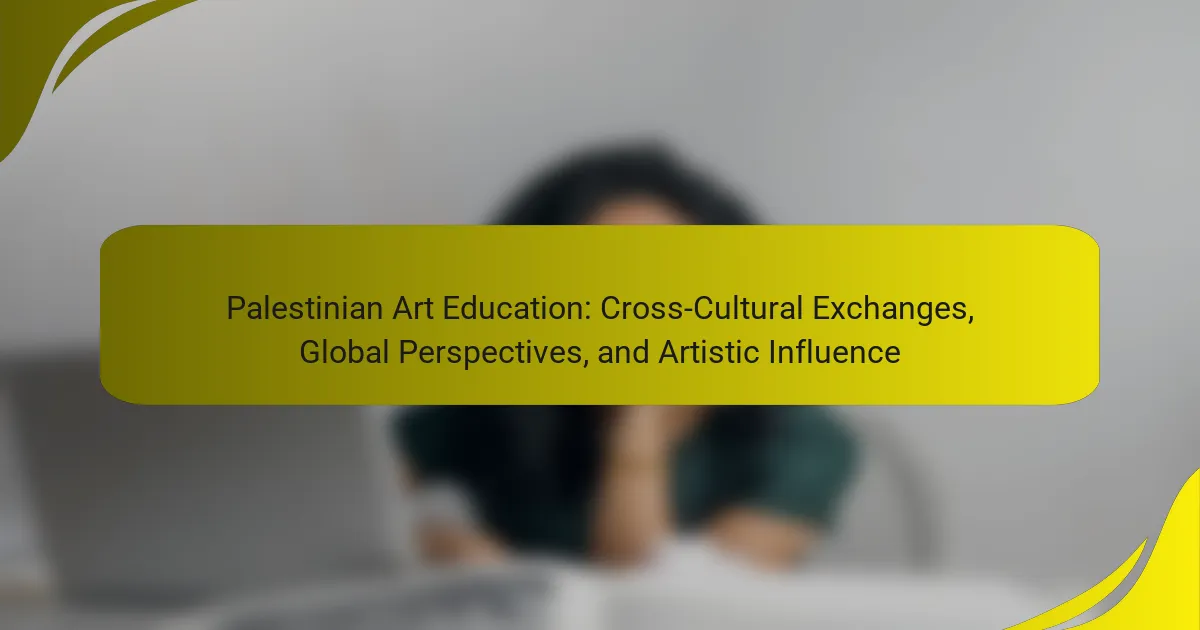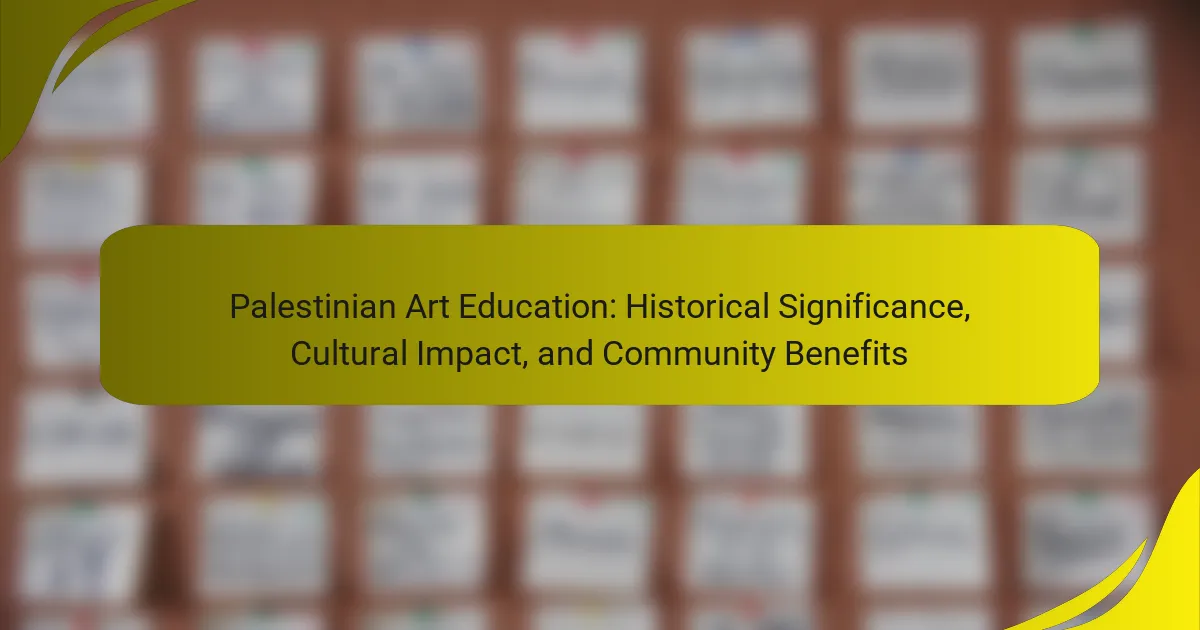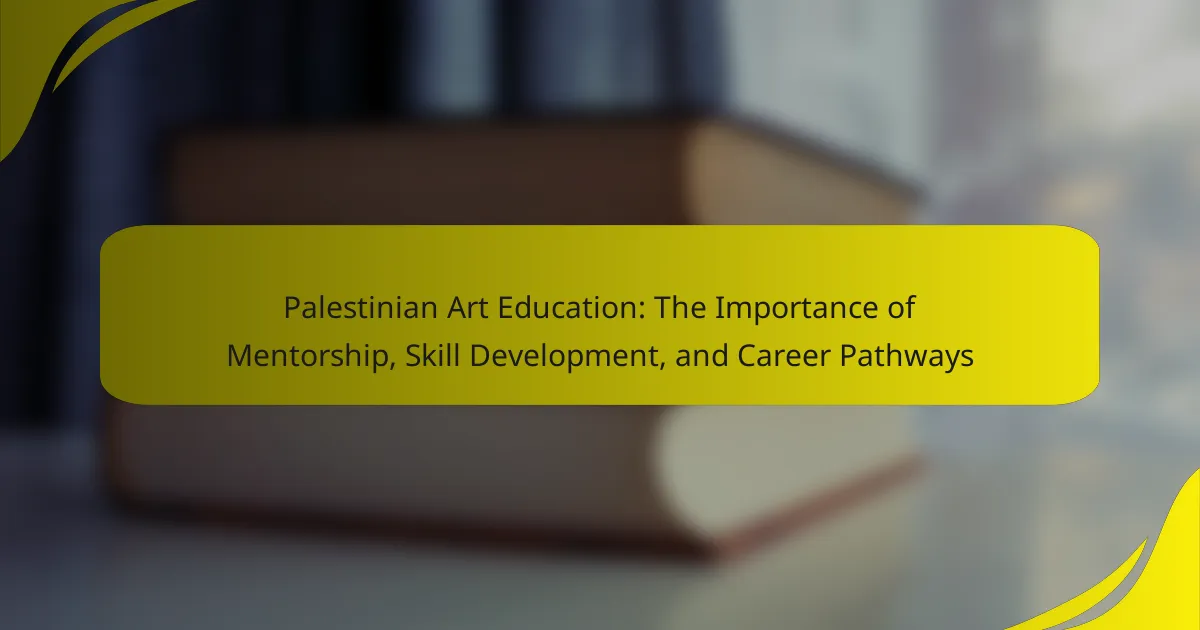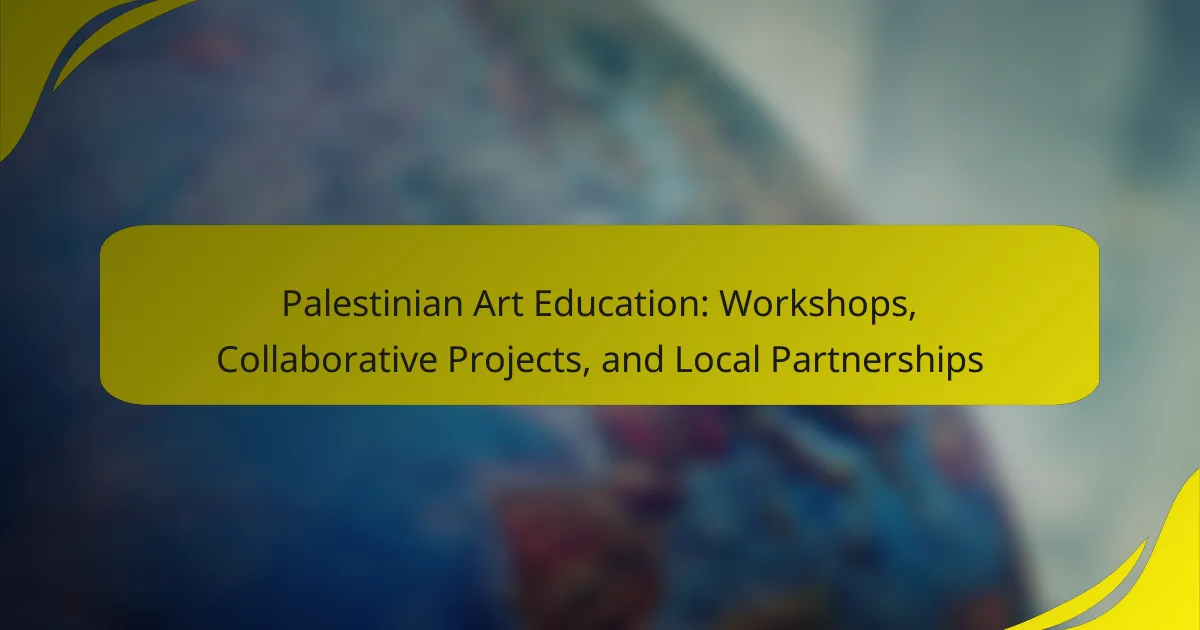Palestinian Art Education encompasses the teaching and promotion of artistic practices within Palestinian communities, focusing on various visual arts such as painting, sculpture, and multimedia. This educational framework aims to foster creativity, cultural expression, and critical thinking among students while addressing themes of identity and social issues. Key challenges include limited resources, funding constraints, and political instability, which hinder access to quality materials and opportunities. Community programs and workshops facilitate artistic dialogue and public engagement, empowering individuals and preserving cultural heritage. Initiatives like community art projects highlight the importance of collaboration and exchange in enhancing student engagement and innovation in artistic practices.
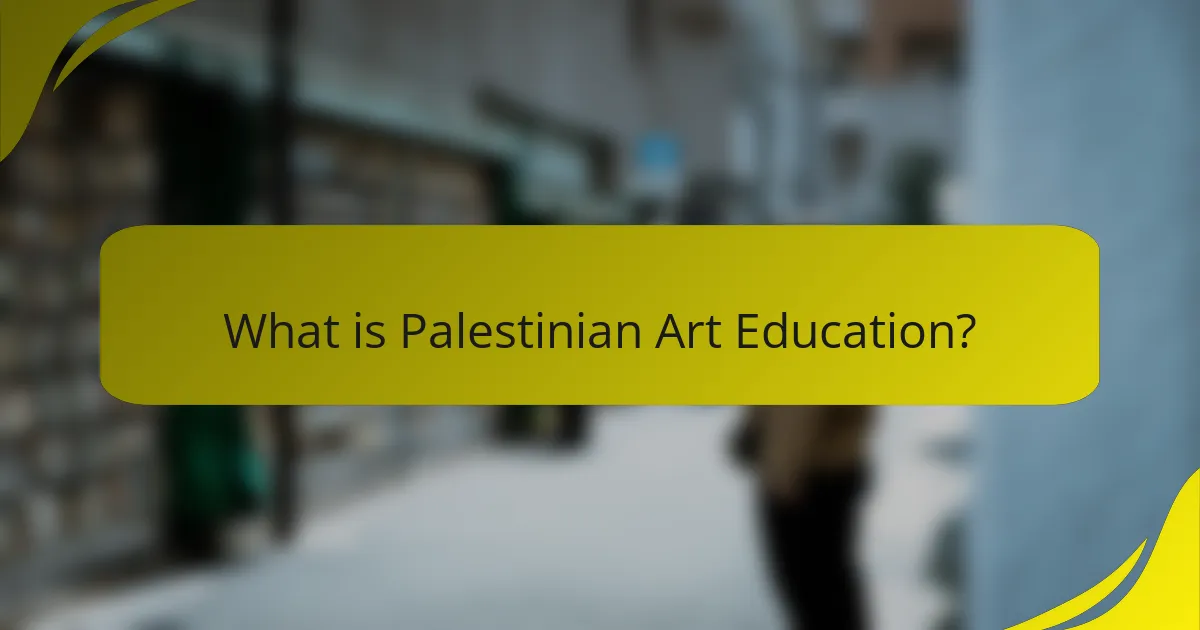
What is Palestinian Art Education?
Palestinian Art Education focuses on teaching and promoting artistic practices within Palestinian communities. It encompasses various forms of visual arts, including painting, sculpture, and multimedia. This educational framework aims to foster creativity and cultural expression among students. It often addresses themes related to identity, history, and social issues. Institutions and community programs facilitate workshops and exhibitions to showcase student work. These initiatives encourage dialogue and engagement with the broader public. Palestinian Art Education plays a crucial role in preserving cultural heritage. It also empowers individuals through artistic skills and critical thinking.
How does Palestinian Art Education contribute to cultural identity?
Palestinian Art Education plays a crucial role in shaping cultural identity. It fosters a sense of belonging and continuity among Palestinians. Through artistic expression, students explore their heritage and collective experiences. This form of education encourages the preservation of traditional narratives and practices. It also promotes dialogue about contemporary issues affecting Palestinian society. Workshops and community exhibitions further enhance this connection to cultural identity. Research indicates that art education helps to strengthen community ties and resilience. This engagement allows for the articulation of a shared Palestinian narrative.
What are the foundational principles of Palestinian Art Education?
The foundational principles of Palestinian Art Education include cultural identity, social justice, and community engagement. Cultural identity emphasizes the importance of expressing Palestinian heritage and narratives through art. Social justice focuses on addressing issues of oppression and inequality within society. Community engagement encourages collaboration and participation among artists and local communities. These principles guide the curriculum and practices in Palestinian art education. They aim to empower students and foster a sense of belonging. Through these principles, Palestinian Art Education seeks to create a platform for dialogue and reflection on societal issues.
How does it reflect the socio-political context of Palestine?
Palestinian art education reflects the socio-political context of Palestine by addressing themes of identity, resistance, and displacement. Artists often use their work to comment on the political situation and social injustices faced by Palestinians. Community exhibitions serve as platforms for dialogue and expression, fostering awareness of local struggles. Public reception of these artworks reveals the community’s engagement with their history and current realities. The interplay between art and politics in Palestine illustrates how cultural expression can challenge narratives and promote solidarity. Additionally, educational initiatives in art encourage critical thinking and empowerment among youth in a politically charged environment.
What role do community exhibitions play in Palestinian Art Education?
Community exhibitions play a crucial role in Palestinian art education. They provide a platform for emerging artists to showcase their work. These exhibitions foster community engagement and dialogue about cultural identity. They also facilitate the exchange of ideas among artists and the public. Community exhibitions highlight the social and political context of Palestinian art. They serve as educational tools, promoting awareness of local artistic practices. Additionally, they encourage collaboration among artists, educators, and institutions. Overall, these exhibitions enhance the visibility and appreciation of Palestinian art within and beyond the local community.
How are community exhibitions organized and executed?
Community exhibitions are organized through collaboration among artists, local organizations, and community members. Initial planning involves defining the exhibition’s theme and objectives. A suitable venue is selected based on accessibility and capacity. Promotion strategies are developed to attract visitors, including social media outreach and community flyers. Artists are invited to submit their works for consideration. A selection committee reviews submissions to ensure alignment with the exhibition’s goals. Installation of artworks occurs prior to the opening, ensuring proper display and arrangement. Finally, an opening event is organized to engage the community and encourage dialogue around the exhibited works.
What types of artworks are typically showcased in these exhibitions?
Community exhibitions of Palestinian art typically showcase a variety of artworks. These include paintings, sculptures, and mixed media pieces. Photography is also a prominent form of expression in these exhibitions. Additionally, installations and performance art may be featured. The artworks often reflect cultural themes and social issues relevant to the Palestinian experience. Many pieces aim to provoke dialogue and foster understanding among diverse audiences. These exhibitions serve as platforms for emerging and established artists alike. They highlight the rich artistic heritage of Palestine and its contemporary narratives.
How is public reception of Palestinian Art Education measured?
Public reception of Palestinian Art Education is measured through surveys, community feedback, and attendance rates at exhibitions. Surveys collect qualitative and quantitative data on audience perceptions and experiences. Community feedback includes direct responses from participants and attendees during events. Attendance rates indicate interest and engagement levels in art education initiatives. These methods provide insights into the effectiveness and impact of art education programs. For instance, a study by the Palestinian Art Academy found that 75% of attendees reported a positive change in their understanding of Palestinian culture through art education.
What factors influence public perception of Palestinian art?
Public perception of Palestinian art is influenced by cultural, political, and historical factors. Cultural identity plays a significant role in how art is interpreted. The political context surrounding the Israeli-Palestinian conflict impacts the themes and messages conveyed in the art. Historical narratives also shape perceptions, as art often reflects the experiences of displacement and resistance. Furthermore, exposure to Palestinian art through exhibitions and media can alter public understanding and appreciation. Engagement with local communities enhances the visibility and relevance of Palestinian artistic expressions. Overall, these factors create a complex landscape that affects how Palestinian art is received and understood globally.
How do community members engage with art exhibitions?
Community members engage with art exhibitions through attendance, participation in discussions, and interaction with artists. They often visit exhibitions to explore cultural expressions and gain insights into local narratives. Community members may participate in guided tours, workshops, or panel discussions that accompany the exhibitions. This engagement fosters dialogue and encourages collective reflection on the themes presented. Research indicates that such interactions enhance community cohesion and cultural appreciation. For example, a study by the Palestinian Art Academy highlighted increased community involvement through collaborative art projects and public forums. These activities not only promote artistic dialogue but also strengthen community ties.
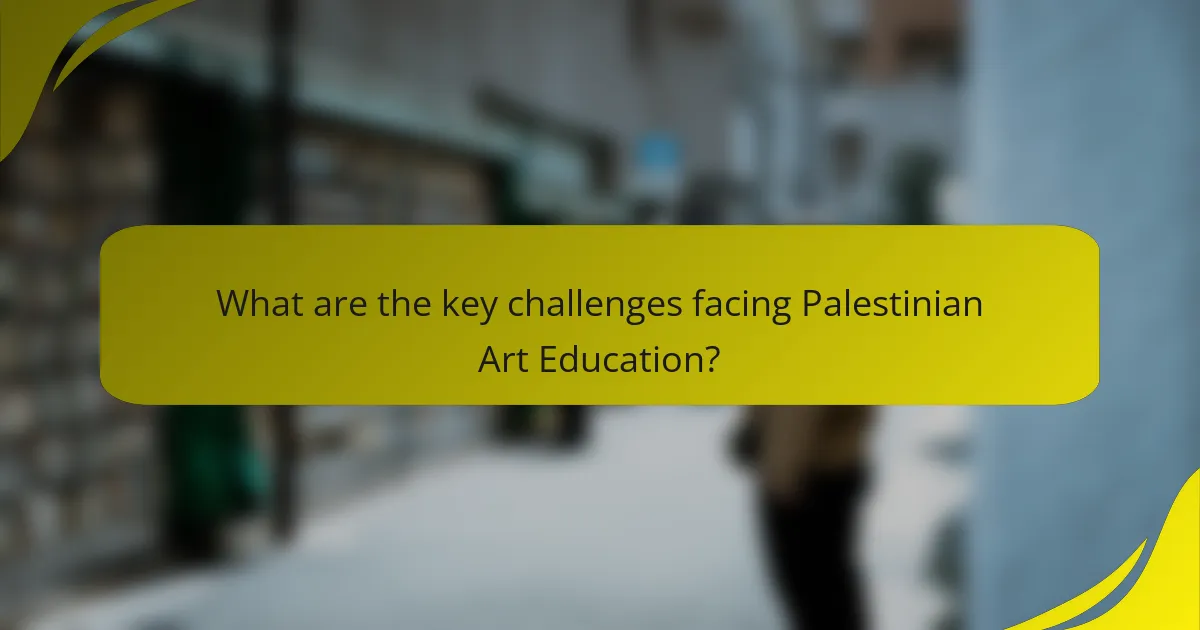
What are the key challenges facing Palestinian Art Education?
Key challenges facing Palestinian Art Education include limited resources and funding. Many art programs struggle due to financial constraints. Access to quality materials and facilities is often inadequate. Political instability affects educational infrastructure and opportunities. Restrictions on movement hinder collaboration and exposure to broader artistic influences. Cultural repression limits freedom of expression in art. Additionally, societal perceptions of art may undervalue its educational importance. These factors collectively impact the growth and development of art education in Palestine.
How do political and economic factors impact art education?
Political and economic factors significantly impact art education by influencing funding, curriculum, and accessibility. In regions with political instability, art programs often face budget cuts. Economic downturns can lead to reduced investment in arts education. For instance, in Palestine, ongoing conflict affects educational resources. Schools may prioritize core subjects over arts due to financial constraints. Additionally, political ideologies can shape the content of art education. Censorship may limit artistic expression in curricula. This creates challenges for educators and students alike. Access to art materials and facilities is also impacted by economic conditions. Overall, the interplay between politics and economics shapes the landscape of art education.
What specific barriers do artists face in Palestine?
Artists in Palestine face significant barriers including political restrictions, limited access to resources, and lack of funding. Political instability affects their ability to exhibit work freely. Restrictions on movement hinder collaboration and access to audiences. Limited funding opportunities restrict project development and sustainability. Additionally, cultural censorship impacts artistic expression. These barriers collectively stifle creativity and limit the visibility of Palestinian art on global platforms.
How do these challenges affect the quality of art education?
Challenges in Palestinian art education diminish the quality of artistic instruction. Limited resources restrict access to materials and facilities. This lack of funding affects the availability of qualified instructors. As a result, students receive less comprehensive training. Cultural and political tensions further hinder creative expression. These factors contribute to a constrained learning environment. Consequently, student engagement and motivation may decline. Overall, these challenges lead to a diminished quality of art education in Palestinian communities.
What strategies are being implemented to enhance Palestinian Art Education?
Strategies to enhance Palestinian Art Education include community-based workshops and collaborative projects. These initiatives promote local artists and engage students in hands-on learning. Educational institutions are integrating art into their curricula, fostering creativity and cultural expression. Partnerships with international art organizations provide resources and exposure. Public exhibitions showcase student work, building confidence and community support. Art festivals and competitions stimulate interest and participation. Online platforms are being utilized for broader outreach and accessibility. These strategies collectively aim to elevate the quality and visibility of art education in Palestine.
How are local organizations supporting art education initiatives?
Local organizations support art education initiatives by providing resources, funding, and community engagement. They often offer workshops and training sessions for artists and educators. Many organizations collaborate with schools to integrate art into the curriculum. They also host exhibitions to showcase student work and promote community involvement. Additionally, local organizations may provide scholarships for art students. They actively seek partnerships with cultural institutions to enhance educational opportunities. This approach fosters a vibrant art community and encourages creative expression among youth.
What role does international collaboration play in these strategies?
International collaboration enhances Palestinian art education strategies by providing access to global resources and networks. It facilitates the exchange of ideas and practices among artists and educators. Collaborative projects can lead to increased visibility for Palestinian art on international platforms. These partnerships often result in joint exhibitions, workshops, and artist residencies. Such initiatives foster cultural dialogue and understanding between communities. Evidence shows that international collaborations have led to successful art programs in conflict-affected regions. They can also attract funding and support from international organizations. This collaborative approach ultimately strengthens the local art scene and promotes artistic innovation.
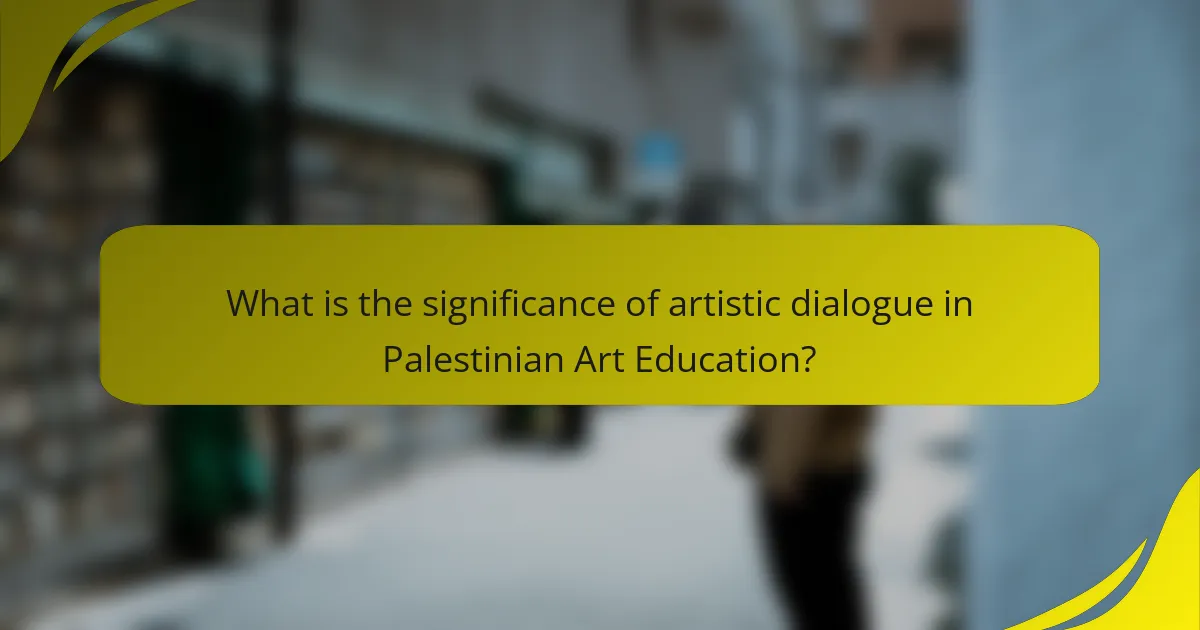
What is the significance of artistic dialogue in Palestinian Art Education?
Artistic dialogue is significant in Palestinian Art Education as it fosters critical thinking and cultural expression. This dialogue encourages students to explore their identities and societal issues through art. It serves as a platform for collaboration and exchange of ideas among artists and educators. Engaging in artistic dialogue helps students develop a deeper understanding of their heritage and contemporary challenges. Research indicates that such exchanges can enhance creativity and innovation in artistic practices. For instance, initiatives like community art projects in Palestine have demonstrated the positive impact of collaborative dialogue on student engagement and empowerment.
How does artistic dialogue foster community engagement?
Artistic dialogue fosters community engagement by creating spaces for shared expression and interaction. It encourages individuals to participate in discussions about their cultural identities. This exchange of ideas enhances mutual understanding among community members. Collaborative art projects often emerge from these dialogues. Such projects can reflect local issues and aspirations. They provide a platform for underrepresented voices. Research shows that communities involved in artistic dialogue report increased social cohesion. For example, a study by the University of California found that art initiatives improved neighborhood relationships. This engagement ultimately strengthens community bonds and fosters a sense of belonging.
What are the methods used to facilitate artistic dialogue?
Methods used to facilitate artistic dialogue include workshops, collaborative projects, and community exhibitions. Workshops provide hands-on experiences that encourage interaction among artists and participants. Collaborative projects foster teamwork and shared creative processes. Community exhibitions showcase local artists and invite public engagement. These methods enhance communication and understanding within artistic communities. They also promote cultural exchange and diverse perspectives. Research indicates that such methods increase participation and enrich the artistic landscape.
How does artistic dialogue influence the themes explored in Palestinian art?
Artistic dialogue significantly influences the themes explored in Palestinian art. It fosters collaboration among artists, leading to diverse perspectives. This exchange allows artists to address shared experiences and cultural identity. Themes often reflect resistance, resilience, and social justice. Artistic dialogue also encourages the exploration of historical narratives. By engaging with local and global contexts, artists can critique political situations. Workshops and community exhibitions amplify these discussions. The resulting artworks resonate with both Palestinian and international audiences, enhancing understanding.
What best practices can be adopted to improve Palestinian Art Education?
Integrating community involvement is a best practice to improve Palestinian Art Education. Engaging local artists and educators fosters a collaborative environment. This can enhance the curriculum and make it more relevant to students’ experiences.
Incorporating technology into art education also proves beneficial. Digital tools can expand access to resources and facilitate remote learning opportunities. This approach has been shown to increase student engagement and creativity.
Providing professional development for educators is essential. Training programs can equip teachers with innovative teaching methods and techniques. Research indicates that well-trained educators significantly impact student outcomes in the arts.
Encouraging interdisciplinary approaches can enrich art education. Integrating subjects like history or literature can provide context and depth to artistic practices. Studies reveal that interdisciplinary learning enhances critical thinking skills.
Establishing partnerships with local and international art institutions can broaden educational horizons. These collaborations can offer workshops, exhibitions, and mentorship opportunities. Such exposure can inspire students and elevate the quality of art education.
Creating safe and inclusive spaces for artistic expression is crucial. These environments encourage students to explore their identities and cultures through art. Evidence suggests that inclusive practices lead to greater student satisfaction and participation.
How can educators incorporate community feedback into art programs?
Educators can incorporate community feedback into art programs by actively engaging local stakeholders. This can be done through surveys, focus groups, and community meetings. These methods allow educators to gather diverse perspectives on the art programs. Incorporating feedback ensures that the programs resonate with community values and needs. For instance, a study by the National Art Education Association highlights how community involvement enhances program relevance. By integrating local culture and traditions, educators can create a more impactful learning experience. This approach fosters a sense of ownership and pride within the community. Ultimately, it leads to more successful and meaningful art education initiatives.
What resources are available for enhancing art education in Palestine?
Art education in Palestine can be enhanced through various resources. These resources include community centers that offer art classes and workshops. Institutions such as the International Academy of Art Palestine provide formal training in visual arts. Online platforms also offer courses and tutorials for remote learning. Additionally, local NGOs often organize art exhibitions and events to promote artistic engagement. Art supplies and materials can be sourced from international donations and local businesses. Collaborations with international artists and educators further enrich the educational landscape. Government initiatives may also support art education through funding and policy development.
Palestinian Art Education is a framework aimed at promoting artistic practices within Palestinian communities, focusing on visual arts and cultural expression. The article explores the role of community exhibitions in enhancing cultural identity, fostering dialogue, and engaging the public in discussions about social issues. It discusses the challenges faced by art education in Palestine, including limited resources and political constraints, while also highlighting strategies for improvement through community involvement and international collaboration. Additionally, the significance of artistic dialogue in shaping themes and enhancing community engagement is examined, providing insights into the impact of art education on Palestinian society.
